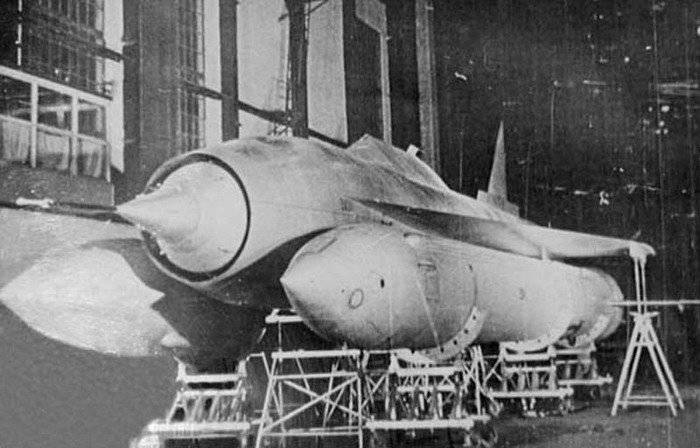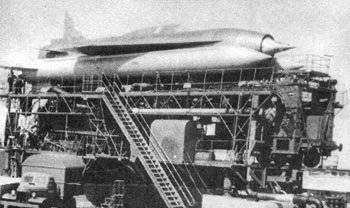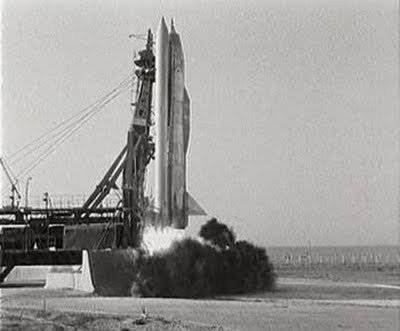We were the first - the Soviet project "Storm", the world's first intercontinental ballistic launch vehicle

To restore justice and to remind everyone of the greatness of the Soviet Union, of the forgotten victory of domestic designers, who surpassed time itself with their project of an intercontinental range cruise missile ...
History project "Storm".
1953 year. The USSR conducts successful tests of the hydrogen bomb. The Soviet Union becomes a nuclear power.
But the presence of a nuclear bomb does not mean that the country has a nuclear weapons. Weapons must be able to apply against the enemy, and for this you need a means of delivering a nuclear bomb into the territory of the enemy. The delivery of the bomb by strategic aircraft was almost immediately rejected - the former allies in the 2 World War II firmly besieged the Soviet Union with dozens of NATO military bases.
The only option that remained was to create a nuclear-powered rocket carrier capable of flying at supersonic speeds far in excess of the speed of sound and delivering the bomb to the enemy’s territory.
First Secretary of the CPSU Central Committee N.S. Khrushchev gives instructions on the creation of an aircraft capable of delivering nuclear weapons to the territory of the United States. At the end of 1953, the government instructs Deputy Chairman of the Council of Ministers Malyshev, in whose office was all nuclear and nuclear energy, to begin work on the development of this project. Malyshev instructs aircraft designer Lavochkin and his deputy Chernyakov to start this project. The project gets the name "Storm".
Lavochkin appoints Chernyakov the chief designer of the project in his OKB-301.
The latest technology used in the project "The Tempest":
- the aircraft had an incredible speed of more than 3M for that time;
- The range of the world's first launch vehicle about 8 000 kilometers;
- for the first time astronavigation is used for flights;
- for the first time a straight-through jet engine was developed and created;
- for the first time a vertical launch is used to launch the aircraft;
- For the first time in the construction of aircraft used titanium.
- For the first time, the latest welding technology for titanium is being introduced.
Project work on the KRMD is fully prepared by the end of 1954 of the year. The rocket was a two-stage. The USSR Ministry of Defense practically approves the project, making, however, small changes. The finalized sketch is ready in 1955. Project approved. Work begins on the creation of a prototype.
[
 b] Main devices and equipment of the Storm project. [/ b]
b] Main devices and equipment of the Storm project. [/ b]To create the world's first supersonic intercontinental rocket as a means of delivering a nuclear weapon to the enemy’s territory, the enormous production capacity of the Soviet Union was used.
The basis of the launch vehicle is an aircraft designed according to an aircraft scheme with a mid-position of a delta wing with a sweep along the leading edge 70 degrees. The "storm" had a thin supersonic profile and a cylindrical body, tapering on both sides.
Inside, along the hull, there was an air intake of a marching ramjet engine “RD-12”, developed by OKB-670 designers. The ramjet engine generated almost 8 tons.
The head of the rocket body was designed as a supersonic diffuser, equipped with a three-stage cone.
Nuclear munition was located in the diffuser, in the head part. Fuel tanks were made in the form of rings, which were located around the circumference of the air channel.
The tail unit was equipped with aerodynamic rudders. Aerodynamic control was in a special front compartment of the fuselage. The compartment had its own cooling. It housed astronavigation equipment. Additionally, this equipment was protected by refractory quartz plates.
The inertial type navigation system - the work of designers under the authority of Tolstousov, the astronavigation equipment - the work of designers OKB-165 - gets the name "Earth". The Volkhov instrument complex is the work of the NII-49 designers.
At the end of the Storm, according to the commands of the autopilot and guidance system, being at an altitude of about 25 000 meters, began a dive to the target, gaining a fantastic speed at that time.
In 1955, the project was submitted for consideration, after which the weight of the nuclear weapon was increased, which led to an overall increase in the mass of the Storm.
The first step was developed by designer Isaev, for her in 1954, the development of the four-chamber rocket engine С2.1000 with a turbo pump began. Accelerators created at the start thrust in 65 tons. Weight finished at the start of the 1-th stage was equal to 54 tons. Jet engines delivered the "Storm" to a height of about 18 kilometers. At this height there was a separation of the first stage and the launch of the second stage. Accelerators created at the factory number XXUMX.
By the beginning of the test, the straight-through RD-012U engine had undergone several major changes. As a result, the engine turned out with a slightly reduced combustion chamber of diameter 17 centimeters, had a THA and a regulation system.
Total SPVRD 18 passed various tests, including in the rocket.
The engine has shown its reliability in the new conditions of high temperatures and speeds. The RD-012U showed fantastic speed at high altitudes, reaching the 3.3 Mach. Reliability of work for a time equal to 6 hours, has not been achieved by similar projects for quite a long time.
The distance to 8 thousand kilometers "The Tempest" could not overcome, but this is not the fault of the RD-012U engine.
 Tests "Storm".
Tests "Storm".Until the end of 1958, the Storm is being followed by a losing streak. Eight starts were considered unsuccessful. December 28 was launched 9-th launch of the "Storm". The flight time of the rocket is a little over 5 minutes. 10 and 11 launch brought success to designers - more than 1300 kilometers at a speed of 3.3 thousands of km / h and more 1750 kilometers at a speed of 3.5 thousands of km / h. It was the first success.
At 12, a launch into the rocket installs astronavigation equipment, but the launch failed.
In the 13 flight, a rocket was lifted by upgraded boosters and a shortened SPRRD “RD-012U”, the flight lasted more than 360 seconds.
14 th start. The rocket broke 4 thousands of kilometers. It was a record for almost all flight indicators of the time.
The tests on the so-called short track have been completed - the distance in 2 is thousands of kilometers.
Began testing at long ranges.
The next four launches went from the Caspian Sea to Kamchatka. At the last launch of the 18, the rocket covered 6.5 thousands of kilometers. 18-th launch took place in mid-December 1960 of the year.
The ramjet engine worked fine, fuel consumption exceeded the expected calculations. Deviation from the target at this distance turned 5-6 kilometers. And although the 8 did not reach thousands of kilometers of a rocket, but the last launches gave confidence about the possible overcoming of this figure.
Began documentary preparation of the rocket for serial production.
The fate of "Storm".
In addition to the project "The Tempest" in the Soviet Union there were several similar projects of launch vehicles of a nuclear warhead. All but one were closed or discontinued. This one is an intercontinental ballistic missile project Р-7, which was used by aircraft designer Korolyov. It was this rocket that became the basis of the first Earth satellite launched into orbit of a manned space flight.
The rocket met all the requirements of the launch vehicle project, and it went into mass production.
The leadership of the Soviet Union makes a decision to reduce development in this area and focus on upgrading and improving the mass production of the launch vehicle.
The aircraft designer Lavochkin, the head of the design office of the Storm project, tried to save the project under any pretext, for example, as a target missile or a UAV.
But Lavochkin passes away. Support "Storm" no longer finds, and the development of a unique project is terminated.
The 5 Storm prototypes remain. Four of them were used and launched for the project development of the UAV-photo reconnaissance aircraft and the development of the target for the Dal air defense system.
A total of 19 prototypes of the Storm project were created.
That's interesting.
At about the same time, the 56-58 year, the United States conducted the development and testing of the NAVAHO G-26 supersonic KR and the G-38 intercontinental rocket. 11 missile launches were made. All ended badly. The program for their creation is completely discontinued.
Main technical data:
- length - 19.9 meter;
- diameter - 1.5 meter;
- Interlock length - 5.2 meter;
- height - 6.65 meter;
- wing span - 7.7 meter;
- weight - 97 tons, after modifications - 130 tons;
- The weight of the warhead - 2.2 tons, after modifications - 2.35 tons;
- oxidizer - nitric acid;
- fuel amines kerosene.
And the last.
If Korolev had not created and had not successfully tested the P-7 launch vehicle, his unique “Storm” would have taken its place in history.
Information